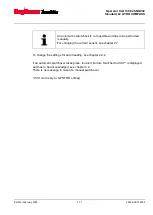
1-13
Standard 30 MF is affected.
Disadvantage: Heading monitoring systems or subsequent systems such as DP
systems are not able to detect heading errors caused by wrong speed or latitude
data.
3.
Input via Standard 22 or Standard 30 MF Gyro Compass (called “Individual Speed
Error Correction” - only available if the system components support this function –
starting with Standard 22 type 110-233.NG002 and higher, Distribution Unit type 138-
118.NG002 and higher- and if configured)
In this application speed and latitude are input to the Standard 22 or Standard 30 MF
Gyro Compass from independent sources – meaning e.g. GPS 1 is connected to
Standard 22 no. 1 and GPS 2 is connected Standard 22 no. 2 (accordingly for
speed). In this application faulty speed or latitude data affect the heading of only one
Standard 22.
Advantage: Heading monitoring systems or subsequent systems such as DP systems
are able to detect heading errors between 2 or more Standard 22 caused by wrong
speed or latitude data.
For dual or triple Standard 22 or Standard 30 MF gyro compass systems not used in
combination with Integrated Navigation Systems (INS):
It is recommended to select “Individual Speed Error Correction” at the Operator Unit.
For dual or triple Standard 22 or Standard 30 MF gyro compass systems used in
combination with Integrated Navigation Systems (INS) such as Synapsis:
It is recommended to select “Automatic Speed Error Correction” at the Operator Unit.
Speed and latitude have been validated by the Consistent Common Reference System
(CCRS) of the INS. Thus, it is a task of the CCRS to ensure that only consistent and
validated sensor data are available to the compass system.
















































